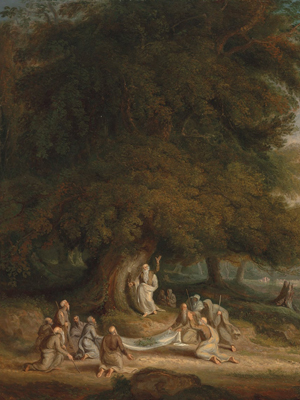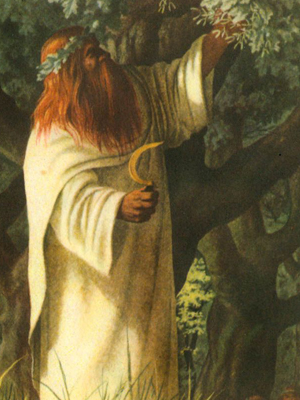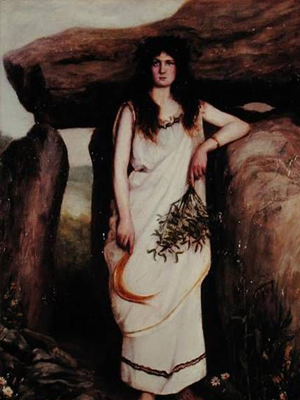Masonic Articles and Essays
Ancient Mysteries and Secret Societies Which Have Influenced Modern Masonic Symbolism - Part Two
Manly P. Hall
Date Published:
10/26/2022
The second installment of Manly P. Hall's chapter on the Ancient Mysteries details the Druidic mysteries of Britain and Gaul and their long felt influence on the development of Masonic rites.
 "The original and primitive inhabitants of Britain, at some remote period, revived and reformed their national institutes. Their priest, or instructor, had hitherto been simply named Gwydd, but it was considered to have become necessary to divide this office between the national, or superior, priest and another whose influence [would] be more limited. From henceforth the former became Der-Wydd (Druid), or superior instructor, and [the latter] Go-Wydd, or O-Vydd (Ovate), subordinate instructor; and both went by the general name of Beirdd (Bards), or teachers of wisdom. As the system matured and augmented, the Bardic Order consisted of three classes, the Druids, Beirdd Braint, or privileged Bards, and Ovates." (See Samuel Meyrick and Charles Smith, The Costume of The Original Inhabitants of The British Islands.)
"The original and primitive inhabitants of Britain, at some remote period, revived and reformed their national institutes. Their priest, or instructor, had hitherto been simply named Gwydd, but it was considered to have become necessary to divide this office between the national, or superior, priest and another whose influence [would] be more limited. From henceforth the former became Der-Wydd (Druid), or superior instructor, and [the latter] Go-Wydd, or O-Vydd (Ovate), subordinate instructor; and both went by the general name of Beirdd (Bards), or teachers of wisdom. As the system matured and augmented, the Bardic Order consisted of three classes, the Druids, Beirdd Braint, or privileged Bards, and Ovates." (See Samuel Meyrick and Charles Smith, The Costume of The Original Inhabitants of The British Islands.)
The origin of the word Druid is under dispute. Max Müller believes that, like the Irish word Drui, it means "the men of the oak trees." He further draws attention to the fact that the forest gods and tree deities of the Greeks were called dryades. Some believe the word to be of Teutonic origin; others ascribe it to the Welsh. A few trace it to the Gaelic druidh, which means "a wise man" or "a sorcerer." In Sanskrit the word dru means "timber."
At the time of the Roman conquest, the Druids were thoroughly ensconced in Britain and Gaul. Their power over the people was unquestioned, and there were instances in which armies, about to attack each other, sheathed their swords when ordered to do so by the white-robed Druids. No undertaking of great importance was scatted without the assistance of these patriarchs, who stood as mediators between the gods and men. The Druidic Order is deservedly credited with having had a deep understanding of Nature and her laws. The Encyclopædia Britannica states that geography, physical science, natural theology, and astrology were their favorite studies. The Druids had a fundamental knowledge of medicine, especially the use of herbs and simples. Crude surgical instruments also have been found in England and Ireland. An odd treatise on early British medicine states that every practitioner was expected to have a garden or back yard for the growing of certain herbs necessary to his profession. Eliphas Levi, the celebrated transcendentalist, makes the following significant statement:
"The Druids were priests and physicians, curing by magnetism and charging amylets with their fluidic influence. Their universal remedies were mistletoe and serpents' eggs, because these substances attract the astral light in a special manner. The solemnity with which mistletoe was cut down drew upon this plant the popular confidence and rendered it powerfully magnetic. * * * The progress of magnetism will some day reveal to us the absorbing properties of mistletoe. We shall then understand the secret of those spongy growths which drew the unused virtues of plants and become surcharged with tinctures and savors. Mushrooms, truffles, gall on trees, and the different kinds of mistletoe will be employed with understanding by a medical science, which will be new because it is old * * * but one must not move quicker than science, which recedes that it may advance the further. " (See The History of Magic.)
Not only was the mistletoe sacred as symbolic of the universal medicine, or panacea, but also because of the fact that it grew upon the oak tree. Through the symbol of the oak, the Druids worshiped the Supreme Deity; therefore, anything growing upon that tree was sacred to Him. At certain seasons, according to the positions of the sun, moon, and stars, the Arch-Druid climbed the oak tree and cut the mistletoe with a golden sickle consecrated for that service. The parasitic growth was caught in white cloths provided for the purpose, lest it touch the earth and be polluted by terrestrial vibrations. Usually a sacrifice of a white bull was made under the tree.
The Druids were initiates of a secret school that existed in their midst. This school, which closely resembled the Bacchic and Eleusinian Mysteries of Greece or the Egyptian rites of Isis and Osiris, is justly designated the Druidic Mysteries. There has been much speculation concerning the secret wisdom that the Druids claimed to possess. Their secret teachings were never written, but were communicated orally to specially prepared candidates. Robert Brown, 32°, is of the opinion that the British priests secured their information from Tyrian and Phœnician navigators who, thousands of years before the Christian Era, established colonies in Britain and Gaul while searching for tin. Thomas Maurice, in his Indian Antiquities, discourses at length on Phœnician, Carthaginian, and Greek expeditions to the British Isles for the purpose of procuring tin. Others are of the opinion that the Mysteries as celebrated by the Druids were of Oriental origin, possibly Buddhistic.
The proximity of the British Isles to the lost Atlantis may account for the sun worship which plays an important part in the rituals of Druidism. According to Artemidorus, Ceres and Persephone were worshiped on an island close to Britain with rites and ceremonies similar to those of Samothrace. There is no doubt that the Druidic Pantheon includes a large number of Greek and Roman deities. This greatly amazed Cæsar during his conquest of Britain and Gaul, and caused him to affirm that these tribes adored Mercury, Apollo, Mars, and Jupiter, in a manner similar to that of the Latin countries. It is almost certain that the Druidic Mysteries were not indigenous to Britain or Gaul, but migrated from one of the more ancient civilizations.
The school of the Druids was divided into three distinct parts, and the secret teachings embodied therein are practically the same as the mysteries concealed under the allegories of Blue Lodge Masonry. The lowest of the three divisions was that of Ovate (Ovydd). This was an honorary degree, requiring no special purification or preparation. The Ovates dressed in green, the Druidic color of learning, and were expected to know something about medicine, astronomy, poetry if possible, and sometimes music. An Ovate was an individual admitted to the Druidic Order because of his general excellence and superior knowledge concerning the problems of life.
 The second division was that of Bard (Beirdd). Its members were robed in sky-blue, to represent harmony and truth, and to them was assigned the labor of memorizing, at least in part, the twenty thousand verses of Druidic sacred poetry. They were often pictured with the primitive British or Irish harp--an instrument strung with human hair, and having as many strings as there were ribs on one side of the human body. These Bards were often chosen as teachers of candidates seeking entrance into the Druidic Mysteries. Neophytes wore striped robes of blue, green, and white, these being the three sacred colors of the Druidic Order.
The second division was that of Bard (Beirdd). Its members were robed in sky-blue, to represent harmony and truth, and to them was assigned the labor of memorizing, at least in part, the twenty thousand verses of Druidic sacred poetry. They were often pictured with the primitive British or Irish harp--an instrument strung with human hair, and having as many strings as there were ribs on one side of the human body. These Bards were often chosen as teachers of candidates seeking entrance into the Druidic Mysteries. Neophytes wore striped robes of blue, green, and white, these being the three sacred colors of the Druidic Order.
The third division was that of Druid (Derwyddon). Its particular labor was to minister to the religious needs of the people. To reach this dignity, the candidate must first become a Bard Braint. The Druids always dressed in white--symbolic of their purity, and the color used by them to symbolize the sun.
In order to reach the exalted position of Arch-Druid, or spiritual head of the organization, it was necessary for a priest to pass through the six successive degrees of the Druidic Order. (The members of the different degrees were differentiated by the colors of their sashes, for all of them wore robes of white.) Some writers are of the opinion that the title of Arch-Druid was hereditary, descending from father to son, but it is more probable that the honor was conferred by ballot election. Its recipient was chosen for his virtues and integrity from the most learned members of the higher Druidic degrees.
According to James Gardner, there were usually two Arch-Druids in Britain, one residing on the Isle of Anglesea and the other on the Isle of Man. Presumably there were others in Gaul. These dignitaries generally carried golden scepters and were crowned with wreaths of oak leaves, symbolic of their authority. The younger members of the Druidic Order were clean-shaven and modestly dressed, but the more aged had long gray beards and wore magnificent golden ornaments. The educational system of the Druids in Britain was superior to that of their colleagues on the Continent, and consequently many of the Gallic youths were sent to the Druidic colleges in Britain for their philosophical instruction and training.
Eliphas Levi states that the Druids lived in strict abstinence, studied the natural sciences, preserved the deepest secrecy, and admitted new members only after long probationary periods. Many of the priests of the order lived in buildings not unlike the monasteries of the modern world. They were associated in groups like ascetics of the Far East. Although celibacy was not demanded of them, few married. Many of the Druids retired from the world and lived as recluses in caves, in rough-stone houses, or in little shacks built in the depths of a forest. Here they prayed and medicated, emerging only to perform their religious duties.
James Freeman Clarke, in his Ten Great Religions, describes the beliefs of the Druids as follows:
"The Druids believed in three worlds and in transmigration from one to the other: In a world above this, in which happiness predominated; a world below, of misery; and this present state. This transmigration was to punish and reward and also to purify the soul. In the present world, said they, Good and Evil are so exactly balanced that man has the utmost freedom and is able to choose or reject either. The Welsh Triads tell us there are three objects of metempsychosis: to collect into the soul the properties of all being, to acquire a knowledge of all things, and to get power to conquer evil. There are also, they say, three kinds of knowledge: knowledge of the nature of each thing, of its cause, and its influence. There are three things which continually grow less: darkness, falsehood, and death. There are three which constantly increase: light, life, and truth."
Like nearly all schools of the Mysteries, the teachings of the Druids were divided into two distinct sections. The simpler, a moral code, was taught to all the people, while the deeper, esoteric doctrine was given only to initiated priests. To be admitted to the order, a candidate was required to be of good family and of high moral character. No important secrets were intrusted to him until he had been tempted in many ways and his strength of character severely tried. The Druids taught the people of Britain and Gaul concerning the immortality of the soul. They believed in transmigration and apparently in reincarnation. They borrowed in one life, promising to pay back in the next. They believed in a purgatorial type of hell where they would be purged of their sins, afterward passing on to the happiness of unity with the gods. The Druids taught that all men would be saved, but that some must return to earth many times to learn the lessons of human life and to overcome the inherent evil of their own natures.
Before a candidate was intrusted with the secret doctrines of the Druids, he was bound with a vow of secrecy. These doctrines were imparted only in the depths of forests and in the darkness of caves. In these places, far from the haunts of men, the neophyte was instructed concerning the creation of the universe, the personalities of the gods, the laws of Nature, the secrets of occult medicine, the mysteries of the celestial bodies, and the rudiments of magic and sorcery. The Druids had a great number of feast days. The new and full moon and the sixth day of the moon were sacred periods. It is believed that initiations took place only at the two solstices and the two equinoxes. At dawn of the 25th day of December, the birth of the Sun God was celebrated.
The secret teachings of the Druids are said by some to be tinctured with Pythagorean philosophy. The Druids had a Madonna, or Virgin Mother, with a Child in her arms, who was sacred to their Mysteries; and their Sun God was resurrected at the time of the year corresponding to that at which modern Christians celebrate Easter.
 Both the cross and the serpent were sacred to the Druids, who made the former by cutting off all the branches of an oak tree and fastening one of them to the main trunk in the form of the letter T. This oaken cross became symbolic of their superior Deity. They also worshiped the sun, moon, and stars. The moon received their special veneration. Caesar stated that Mercury was one of the chief deities of the Gauls. The Druids are believed to have worshiped Mercury under the similitude of a stone cube. They also had great veneration for the Nature spirits (fairies, gnomes, and undines), little creatures of the forests and rivers to whom many offerings were made. Describing the temples of the Druids, Charles Heckethorn, in The Secret Societies of All Ages & Countries, says:
Both the cross and the serpent were sacred to the Druids, who made the former by cutting off all the branches of an oak tree and fastening one of them to the main trunk in the form of the letter T. This oaken cross became symbolic of their superior Deity. They also worshiped the sun, moon, and stars. The moon received their special veneration. Caesar stated that Mercury was one of the chief deities of the Gauls. The Druids are believed to have worshiped Mercury under the similitude of a stone cube. They also had great veneration for the Nature spirits (fairies, gnomes, and undines), little creatures of the forests and rivers to whom many offerings were made. Describing the temples of the Druids, Charles Heckethorn, in The Secret Societies of All Ages & Countries, says:
"Their temples wherein the sacred fire was preserved were generally situate on eminences and in dense groves of oak, and assumed various forms--circular, because a circle was the emblem of the universe; oval, in allusion to the mundane egg, from which issued, according to the traditions of many nations, the universe, or, according to others, our first parents; serpentine, because a serpent was the symbol of Hu, the Druidic Osiris; cruciform, because a cross is an emblem of regeneration; or winged, to represent the motion of the Divine Spirit. * * * Their chief deities were reducible to two--a male and a female, the great father and mother--Hu and Ceridwen, distinguished by the same characteristics as belong to Osiris and Isis, Bacchus and Ceres, or any other supreme god and goddess representing the two principles of all Being."
Godfrey Higgins states that Hu, the Mighty, regarded as the first settler of Britain, came from a place which the Welsh Triads call the Summer Country, the present site of Constantinople. Albert Pike says that the Lost Word of Masonry is concealed in the name of the Druid god Hu. The meager information extant concerning the secret initiations of the Druids indicates a decided similarity between their Mystery school and the schools of Greece and Egypt. Hu, the Sun God, was murdered and, after a number of strange ordeals and mystic rituals, was restored to life.
There were three degrees of the Druidic Mysteries, but few successfully passed them all. The candidate was buried in a coffin, as symbolic of the death of the Sun God. The supreme test, however, was being sent out to sea in an open boat. While undergoing this ordeal, many lost their lives. Taliesin, an ancient scholar, who passed through the Mysteries, describes the initiation of the open boat in Faber's Pagan Idolatry. The few who passed this third degree were said to have been "born again," and were instructed in the secret and hidden truths which the Druid priests had preserved from antiquity. From these initiates were chosen many of the dignitaries of the British religious and political world. (For further details, see Faber's Pagan Idolatry, Albert Pike's Morals and Dogma, and Godfrey Higgins' Celtic Druids.)
More Masonic Articles
Explore articles and essays written by Freemasons about Freemasonry.
Read More
Membership
Interested in becoming a member of the worlds oldest Fraternal organization?
Read More